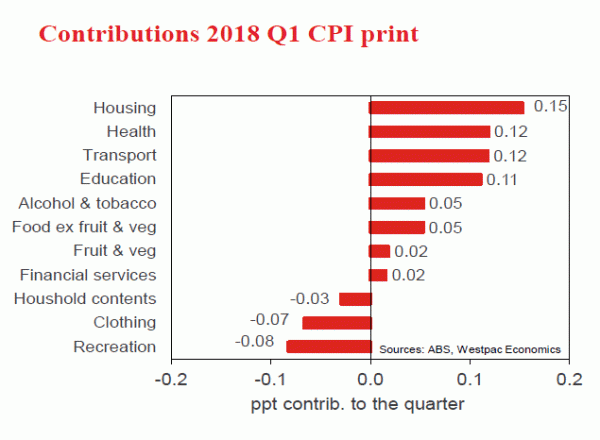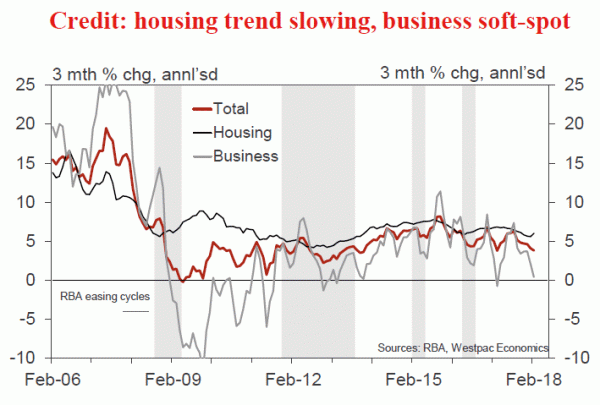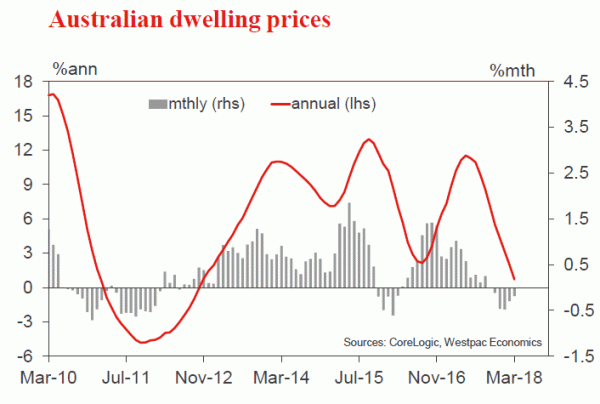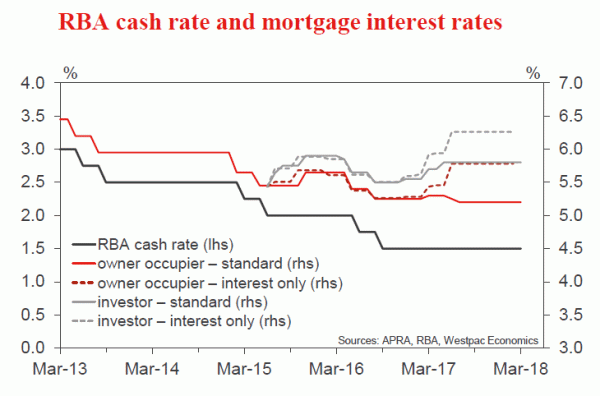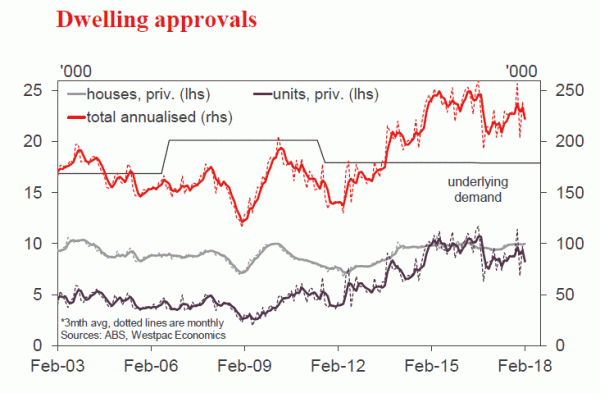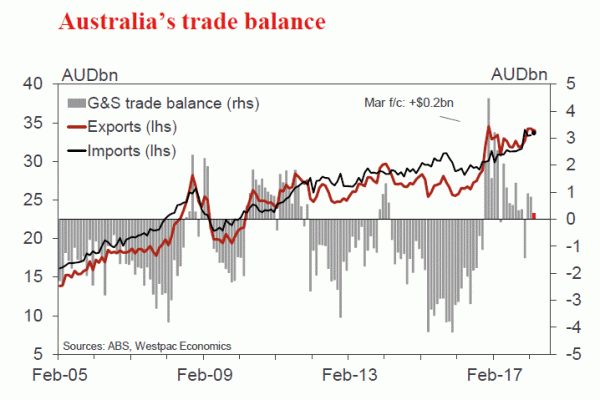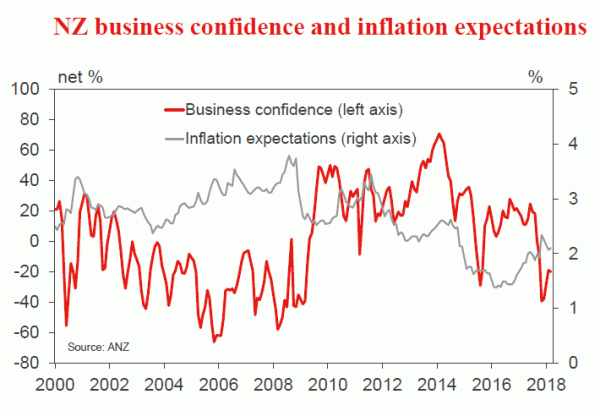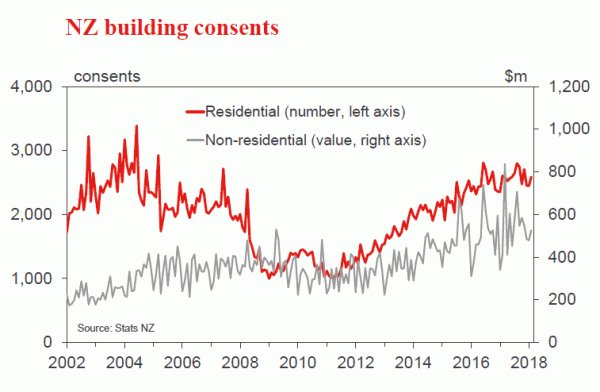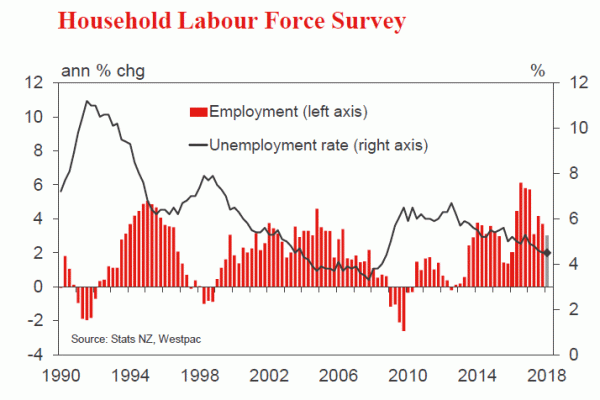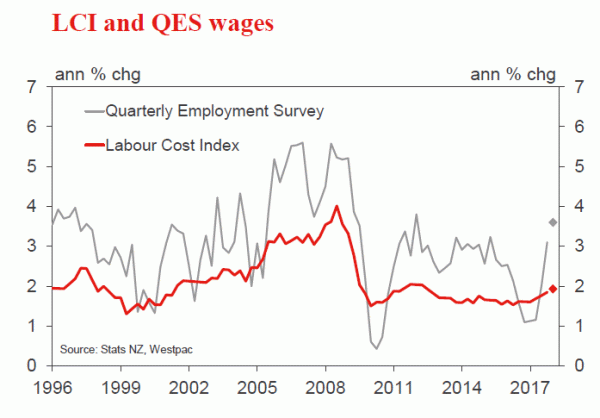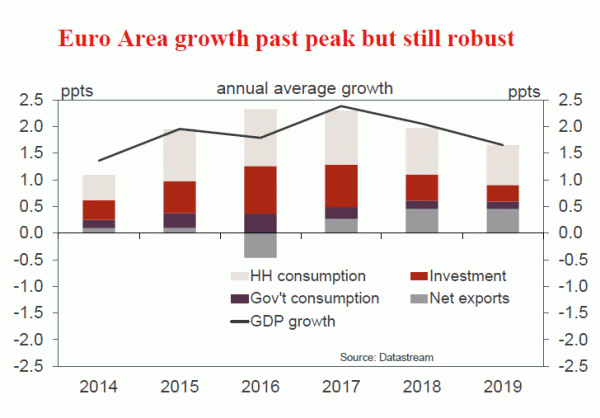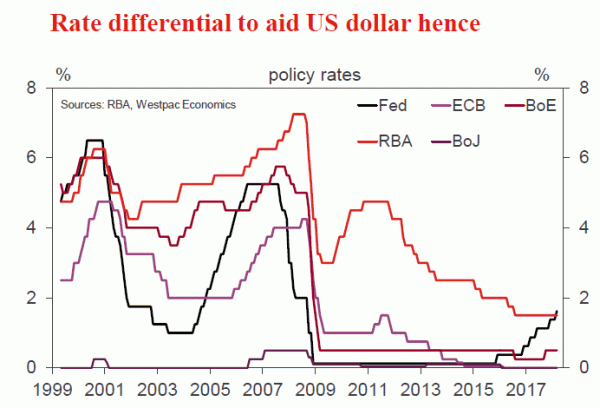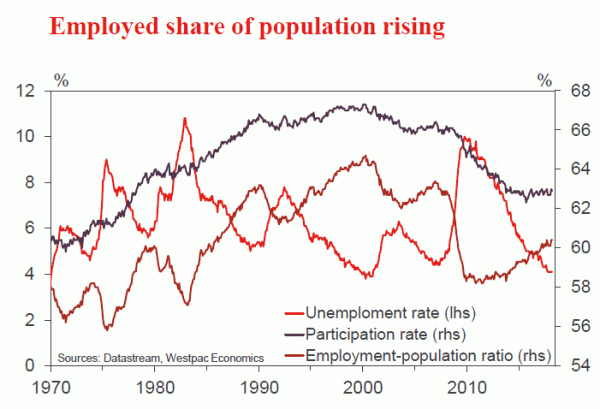Week beginning 30 April 2018
- RBA to hold stance but likely to lower growth forecast.
- RBA: policy decision, Governor Lowe speaks, Statement on Monetary Policy.
- Australia: dwelling approvals, house prices, private credit, trade balance.
- NZ: labour force survey, business confidence, building consents.
- China: Official NBS and Caixin PMIs.
- Euro Area: Q1 GDP.
- US: FOMC meeting, Treasury’s Quarterly Refunding announcement, nonfarm payrolls.
- Key economic & financial forecasts.
Information contained in this report current as at 27 April 2018.
RBA to Hold Stance but Likely to Lower Growth Forecast
The Reserve Bank Board meets next week on May 1. The decision is certain to be to hold rates steady for another month.
We do not expect to see any significant changes in the Governor’s Statement, although it will be interesting to see whether he follows the lead on the April minutes and notes “members agreed that it was more likely that the next move in the cash rate would be up, rather than down”. Note that he did not use that terminology in his Statement on April 3 just the April Board minutes.
I have no doubt that such sentiment will be retained by the Board in the minutes but adopting that terminology in the Statement seems unlikely. Using that sentence in the much shorter Statement does impact flexibility given that if that sentence becomes “standard” then any exclusion of the sentence might be interpreted as a signal to preference lower rates even before the decision had been reached.
There have been a number of significant developments, particularly in financial markets, since the last Board meeting on April 3.
The US 10 year bond rate has risen from 2.77% to 3.03% The “2.77%” was described by the Governor as “still low”, whereas 3.03% is the highest 10 year bond rate since January 2014 during the “Taper Tantrum”. At that time markets were expecting the cessation of QE to lift bond rates significantly despite ample spare capacity in the economy. That action proved to be an over-reaction. This time markets are responding to the prospects of a huge fiscal stimulus in the US being superimposed on an economy with little spare capacity. Inflation risks have lifted pointing to a further sustained lift in bond rates.
The Governor also seems very “relaxed” about the rise in short term interest rates due to changes in both demand and supply conditions in US money markets. “Financial conditions generally remain expansionary. There has, however, been some tightening of conditions in US dollar short-term money markets, with US dollar short-term interest rates increasing for reasons other than the increase in the federal funds rate. This has flowed through to higher short-term interest rates in a few other countries, including Australia”.
Combined with the rise in the long bond rates that sentiment seems somewhat over relaxed. That may be because the Bank expected conditions to ease in the money market. In fact, the three month LIBOR spread to OIS is only around 5bps off its mid April peak. The direct impact that increase is having on short term rates in Australia can be seen with the lift in BBSW from 2.03% to 2.08% inter Board meetings but that has since come back to 2.045%. Any potential easing in that rate as might have been indicated by the fairly relaxed assessment from the Governor in April has been dashed and the Statement may well refer to a marked tightening in financial conditions.
Further, although interest rate conditions have tightened the AUD has not fallen much to compensate. In TWI terms the AUD has fallen around 0.1% despite a fall in USD terms from USD0.77 to USD 0.755.
The labour market also seems to be slowing down. Jobs growth has moderated from the 3.4% in 2017 to a three month annualised pace of 1.2% in 2018. Perhaps the Governor might “tone down” his obvious exuberance around the labour market.
Next week we also see the release of the Statement on Monetary Policy.
In the Statement the Bank has an opportunity to review forecasts. The only forecasts contained in the SOMP are for GDP growth; inflation (both headline and underlying) and the unemployment rate. Recall that in February the Bank expected GDP growth to lift from 2.5% in 2017 to 3.25% in 2018 and 2019 – that is 0.5% above trend and would certainly be consistent with rising inflation pressures as the output gap closed.
Signals from the Bank on the growth outlook have varied: a bit above 3%; trend; and stronger than last year. My expectation is that the Bank will back off a little with its 2018 growth forecast from 3.25% to 3.0%. The 2019 forecast will remain the same at 3.25%.
It is interesting to observe that the Bank’s growth forecasts in February were above the Government’s forecasts in the Mid- Year Economic and Fiscal Outlook (released in December). The Government forecast fiscal year (year average) growth of 2.5% (2017/18); 3.0% (2018/19); and 3.0% (2019/20).
The Bank’s equivalent forecasts are: 2017/18 (2.75%); 2018/19 (3.25%) and 2019/20 (3.25%).
It is likely that when the Government refreshes its forecasts for the May Budget (announced on May 8) it will retain its MYEFO numbers. Different views in the “official family” are not uncommon but the changed rhetoric at the Bank and the lower official forecasts point to a change in the May SOMP.
A second forecast in the SOMP which is of interest is the forecast for underlying inflation. In February the Bank forecast: 1.75% (Dec 2017); 1.75% (Dec 2018); 2% (Dec 2019) and 2.25% (June 2020).
The body of the SOMP specifically discusses the Trimmed Mean when referring to Inflation so it is reasonable for us to follow suit.
Recall that the Bank’s track record with the Trimmed Mean has been disappointing in recent years. In the year to December 2016 (1.6%); and 2017 (1.8%).
The forecast for underlying inflation to December 2018 is 1.75% and to December 2019 the forecast is 2.0%. In the last 11 quarters the Trimmed Mean has printed: 0.3 (x2); 0.4 (x4); 0.5 (x4); and 0.6 (x1).
There is clearly no sign of any uptrend in the Trimmed Mean although the measure for March, which printed on April 24 was 0.5.
If the Bank were to raise the 1.75% forecast for December 2018 to 2.0% there would be no real raised eye brows although it would be based on the Trimmed Mean stringing together a series of 0.5’s – not supported by the track record.
Such an adjustment would signal a more confident assessment of the inflation outlook as a result of the March quarter Inflation Report. We do not think that conclusion is justified.
With the exception of motor vehicles (which fell a significant 1.1% in the September quarter) the evidence of ongoing competitive pressures impacting deflationary forces on Australia’s inflation rate were once again apparent. Clothing and footwear fell 2.0%; household contents fell 0.4%; communication fell 0.4%; audio visual fell 4.1% and holiday travel fell 0.5%. There was some emerging evidence of the impact of the weakening housing market on inflation with “house purchase” (the cost of building a new home excluding land value) up only 0.5% (a figure around 1% has been consistent with a solid market) and rents remaining particularly weak at 0.2%.
Overall the Statement and the SOMP are unlikely to see any significant changes in market sentiment.
The week that was
Market attention was captured by the US 10 year treasury’s venture above 3% and a jump in the USD saw the AUD cross fall to 0.755, while the notion of peak earnings saw developed market equities tread water. In terms of data, the focus in Australia was on the Q1 CPI release.
Q1 Australian CPI printed at 0.4% (0.45% at two decimal places) just below the market consensus of 0.5%. That marks six consecutive quarters where the consensus has overestimated the CPI. However, the core measures met expectations with both the trimmed mean and weighted median rising 0.5% with the annual pace of the average of the core measures ticking up to 2.0%yr, just at the bottom of the RBA’s 2-3% target band. Tradable prices continue to be a drag down 0.5%yr as the competitive margin squeeze in the retail sector remains a significant factor. Nontradables have been holding up inflation at 3.1%yr. Health and education had their normal Q1 price reset but the pace softened compared to what it was a few years back and in regards to housing costs, the push from rising utilities have been more muted than expected. In short, the Q1 result continues to suggest there are few signs of inflationary pressure in Australia.
On the RBA, Assistant Governor Kent gave a speech on interestonly (IO) loans. The 2017 macroprudential measures were targeted at slowing IO loan growth and included a cap of 30% on their proportion of new mortgages. Ultimately this saw a rise in IO interest rates and many borrowers switched to principal and interest (P&I) but some remained on IO. For the borrowers that remained on IO, the 30% cap means that some will not be able to roll over their interest-only period come expiry and will consequently need to switch to P&I. The key take out from Kent’s speech is that while the RBA acknowledge that the ‘step-up’ to P&I payments for some individual households is non-trivial, they estimate that the aggregate cash flow effect is small and will only have a marginal effect on total household consumption.
Also to do with macroprudential, APRA has removed the investor lending cap and now expects banks to introduce their own lending restrictions. APRA stated that lending standards have improved since the 10% cap on investor credit growth was introduced in late-2014. The cap will be removed on July 1 for lenders that have been operating below the benchmark for six months, and can confirm their lending policies meets guidance on serviceability. APRA Chairman Byres also stated that there is more to do to strengthen the assessment of borrower expenses and existing debt, and the oversight of lending outside of policy.
Ahead of the budget, Treasurer Scott Morrison spoke to the Australian Business Economists, “Lower taxes for a stronger economy”. The Federal Budget is to be delivered on May 8, potentially the final annual budget ahead of the next Federal Election which is due by May 18 2019. The budget position for 2017/18 is running ahead of forecast by around $10bn after the recent unexpected resilience of commodity prices and the jobs surge in 2017. The Government is scrapping the Medicare levy increase announced in the May 2017 Budget and is likely to announce personal income tax cuts in this years’ Budget.
Across the Tasman, March net migration in New Zealand rose by 5.5k. Net migration has been easing back since mid-2017 and in annual terms, it is now just under 68k. While that is still strong, it is the lowest level in two years. Our economics team in NZ also put out a piece this week on their not so dissimilar inflation outlook.
Starting the week internationally, flash Markit manufacturing PMIs jumped to a 43 month high in the US but held fairly steady in Europe and Japan. Europe and Japan eased back through the first quarter of 2018, consistent with similar plateauing seen in other major Asian economies.
Over to central banks, the ECB held its policy stance and gave little away before their June 14 meeting which includes updates to their quarterly growth and inflation forecasts. The most interesting point from the press conference was Draghi’s recount of member’s discussion on current conditions. He noted that all countries (to different extents) reported some moderation in growth and that it was broad-based across sectors. Though this was unexpected, he emphasised that indicators are still above average and that the easing in momentum follows a period of strong growth. As such, they view the slowing as a normalisation but also acknowledge that temporary factors have played a part. All in all, Draghi described the ECB’s view on recent data prints as “caution tempered by an unchanged confidence of the convergence of inflation to our inflation aim”.
We also saw the Swedish Riksbank hold rates but surprise with a change in forward guidance. The Riksbank now expect to hike rates “towards the end of the year” as opposed to their previous statement of the “second half of this year”.
As we go to publication, the BoJ policy hold came with little surprise and we are still awaiting US Q1 GDP and the Q1 ECI.
Chart of the week: CPI component contribution
So far in 2018 we struggle to find any broad inflationary pressure in the Australian economy. Core inflation is just at the bottom of the RBA’s target band (held there by non-traded prices and in particular housing, health and education) and we can find little to suggest a risk of a dangerous acceleration. But nor can we find signs that the disinflationary pulse is widening suggesting we could see a significant dip in the rate of core inflation.
A number of sectors are stuck in a disinflationary or even deflationary cycle while the normal cyclical inflationary push you would expect at this point in the cycle is absent. Will analysts now over adjust their estimates for inflation for this and the next quarter we see an upwards surprise from inflation? It is possible but we feel it is an unlikely outcome.
New Zealand: week ahead & data wrap
In recent years, the combination of low interest rates and the favourable tax treatment of housing saw house prices rising rapidly. These same conditions also saw household debt rising to record levels. Now, with the housing market cooler than it was in previous years, the creep upwards in household debt has slowed. And over the coming years, policies aimed at dampening housing market pressures will put a brake on further debt accumulation. These changes also signal an important drag on households’ spending, and will have an important impact on the RBNZ’s policy stance.
Household debt levels in New Zealand have risen by 35% since 2012. That’s roughly double the increase in incomes over the same period. As a result, households are now carrying debt that is equivalent to 168% of their annual disposable income – a level that’s well above the peak of 159% that we saw just prior to the financial crisis.
As we’ve previously highlighted, the major contributor to the run up in household debt has been the low level of interest rates in recent years, and the related increases in house prices. With low interest rates generating low nominal returns on savings, investors have sought to diversify into housing and other assets. Combined with the favourable tax treatment of investment housing in New Zealand, this boosted the demand for housing assets and pushed house prices higher. Aspiring buyers have had to borrow more. In addition, as has historically been the case, strength in the housing market also saw homeowners spending some of the windfall they perceive when the value of their house rises. The net effect has been more borrowing and more spending, with the low cost of borrowing reinforcing both of these trends.
In recent years, this run up of household debt has raised concerns about the economy’s longer-term financial stability. That includes concerns about the eventual drag on economic activity from increased debt servicing obligations, particularly if interest rates rise. In addition, higher debt levels mean that the economy is more vulnerable to unfavourable changes in economic or financial conditions, especially as such disruptions could be amplified through changes in the housing market. Such concerns are a key reason why the RBNZ introduced restrictions on high loan-tovalue (LVR) lending in recent years.
However, while debt levels are at historically high levels, the past year has actually seen debt accumulation slowing, and the ratio of household debt to income has been steady since the start of 2017. That follows the slowdown in house price inflation over the past year that came as a result of a tightening in lending restrictions by the RBNZ, as well as an increase in mortgage rates in early 2017.
In recent months, the housing market has firmed again as borrowing restrictions have been eased and mortgage rates have pushed down again. At the same time, mortgage borrowing has picked up a little. However, as we discussed in our recent Home Truths report1, we expect this resurgence will be short lived. The Government plans to roll out a series of policies aimed at dampening housing market conditions. That includes policies affecting physical demand and supply, such as restrictions on foreign buyers, a tightening in migration settings, and efforts to increase the housing stock (such as the KiwiBuild program).
More important, however, are a range of policies that will affect the financial incentives associated with property investment. The Government has already extended the holding period for taxing capital gains on investment properties from two to five years (the so-called ‘bright line’ test). Over the coming years we also expect the ability to use losses on rental properties to offset other tax obligations (i.e. negative gearing) will be significantly curtailed. Finally, there is the possibility that the government will look at introducing a broad-based capital gains tax if elected to a second term in office.
This wide reaching suite of policies will significantly dampen the demand for housing, especially by investors. Consequently, we expect that the nationwide level of house prices will fall by a total of 2% over the next four years.
The slowdown in the demand for housing will also put the brakes on debt accumulation, with debt to income levels expected to remain broadly stable over the next few years. This will have important implications for the Reserve Bank’s choice of policy settings, potentially allowing for a further loosening of LVR lending restrictions. A slowdown in the housing market will also be important for monetary policy and the level of the Official Cash Rate. As discussed below, the slowdown in the housing market will have a more general dampening impact on economic activity, removing any need for the RBNZ to hike the OCR in the near term.
New Zealanders hold a significant proportion of their wealth in either investment or owner-occupied housing. As a result, we expect that the coming slowdown in the housing market will also see softness in household spending growth. This is likely to be reinforced by associated changes in the access to credit. The strong housing demand that encouraged the build-up of debt in recent years also pushed up house prices. That flattered household debt positions, with debt-to-asset ratios falling. However, the stalling in the housing market over the past year has seen debt-to asset positions rising modestly. And with further housing market softness expected, such gauges of the economy’s financial health could deteriorate further. In such circumstances, many borrowers could find their borrowing ability curtailed, while debt servicing requirements result in their disposable incomes being squeezed.
Policy changes also mean that the Government will be collecting more tax from rental properties over the coming years. This signals a further drag on households’ disposable incomes and spending.
The run up in household debt in recent years and associated increases in financial vulnerabilities are important clouds on the horizon, but are unlikely to topple the economy. Despite the increase in debt levels, low interest rates mean that households’ debt servicing costs remain modest: households currently spend an average of 8.3% of disposable incomes on debt servicing (well below the peak of 14% in 2009). On top of this, the labour market is in good health, and New Zealand hasn’t had difficulties funding its current account deficit in recent years.
Data Previews
Aus Mar private credit
Apr 30, Last: 0.4%, WBC f/c: 0.4%
Mkt f/c: 0.4%, Range: 0.3% to 0.6%
- Private sector credit is expanding at a modest pace as the housing sector cools. In 2017, credit grew by 4.9%, slowing from 5.6% for 2016, with a Q4 average of 0.4% per month.
- For March, we expect a rise of 0.4%.
- Housing credit, at this late stage of the cycle, is slowing in response to tighter lending conditions. The 3 month annualised pace was 5.6% in January, down from 6.8% last March. However, in February, a surprise uptick – most likely noise – saw the 3 month pace rebound to 6.0%.
- Business credit, up 3.6% over the year, is volatile around a modest uptrend as businesses increase investment in the real economy. Over the past three months, business credit hit a soft spot, with outcomes of +0.1%, -0.1% and +0.1%. On balance, current fundamentals are positive pointing to a resumption of the modest uptrend.
Aus Apr CoreLogic home value index
May 1, Last: -0.2%, WBC f/c: -0.2%
- Australia’s housing market continue to see price slippage in early 2018, the CoreLogic home value index dipping another 0.2% in March to be down 1.4% from its Oct peak.
- The detail shows more pronounced weakness in Sydney, for houses as opposed to units, and for the top 25% of properties by value.
- The daily index points to a further 0.2% decline in April that will take annual growth down to -0.3%yr, the first negative since 2012.
Aus RBA policy announcement
May 1, Last: 1.50%, WBC f/c: 1.50%
Mkt f/c: 1.50%, Range: 1.50% to 1.50%
- The RBA Board will leave rates unchanged at their May meeting, as they have since they cut rates in August 2016.
- The Governor has stated that: “further progress in reducing unemployment and having inflation return to target is expected, although this progress is likely to be gradual”.
- The case for patience has been reinforced by recent data. Notably, inflation remained subdued in Q1 at 0.4%qtr, 1.9%yr. The jobs hiring boom of 2017, +3.4%yr, has given way to a consolidation in Q1, 1.9% annualised, and the unemployment rate has stalled at 5.5% after declining early in 2017.
- The RBA will likely trim their 2018 GDP growth forecast in the Statement on Monetary Policy to a still above trend 3.0%, rounded down from 3.25% previously.
- We expect GDP growth to be less robust, at 2.75% this year, slowing to 2.5% in 2019 and anticipate that the RBA will keep the cash rate unchanged at 1.5% in 2018 and 2019.
Aus Mar dwelling approvals
May 3, Last: -6.2%, WBC f/c: 1.0%
Mkt f/c: 1.0%, Range: -3.0% to 5.0%
- Dwelling approvals retraced 6.2% in Feb, giving back about two fifths of the 17.2% jump in Jan. Approvals have been extremely volatile month to month, making it difficult to pick out clear trends. Volatility has again centred on ‘high rise’ approvals.
- Construction-related housing finance approvals have softened since Sep after rallying through most of 2017. Given lags between finance and construction, that suggests non high rise dwelling approvals will fall away a bit in coming months.
- High rise is harder to call. The general picture from site purchases over the last year points to the segment taking another leg lower in 2018 although the month to month moves look to have overshot a little in Feb.
- On balance we expect total approvals to be up 1% in March.
Aus Mar trade balance, AUDbn
May 3, Last: 0.8, WBC f/c: 0.2
Mkt f/c: 0.95, Range: -0.5 to 1.3
- For March, Australia’s trade surplus is expected to narrow to $0.2bn from $0.8bn, led lower by exports.
- Export earnings are forecast to contract by 1.0% in March, down $350mn. The key negative, the iron ore spot price retreated from recent highs, declining to US$70/t from $76.50.
- The import bill rose a forecast 0.8% in the month, +$250mn. The cost of imports increased as the currency weakened, down around 1.5% to 76.7US¢ from 78.8US¢.
- Focusing on the March quarter, the trade balance improved to a surplus of $2.0bn, a turnaround from a deficit of $0.7bn in Q4 – based on our forecast and subject to revisions. The improvement was centred on a rise in the terms of trade associated with higher commodity prices (on a quarter average basis).
NZ April ANZ business confidence
April 30, Last: -20
- Business confidence treaded water in March, after bouncing off its post-election lows in back in February.
- While the economic backdrop has been steady over the last month, the Government did surprise some with the timing of its announcement to end offshore oil exploration permits. But it’s an open question whether this will have an impact on broader business sentiment.
- March quarter CPI came out in line with expectations, but this did see the annual inflation rate drop fairly sharply to 1.1%. This could put downward modest pressure on the inflation expectations components of the survey, which were little changed in March.
NZ Mar residential building consents
May 1, Last: 5.7%, WBC f/c: 1.6%
- Residential building consent issuance rose 5.7% in February after a flat outturn in the previous month. The solid lift in consent issuance was driven by a pickup in issuance for multiple dwelling/apartments.
- While strong population growth signals the need for a protracted period of rapid home building, we expect construction activity to rise at a gradual pace. Construction firms are highlighting shortages of skilled labour and difficulties with financing as important brakes on the pace of building.
- We’ll be watching the regional breakdown of consents closely. Despite a large and growing shortage of homes, building levels in Auckland have flattened off in recent months. We’re also seeing a trend decline in Canterbury as the region’s housing market continues its gradual postearthquake transition.
NZ Q1 Household Labour Force Survey
May 2, Employment last: 0.5%, WBC f/c: 0.3%, Mkt f/c: 0.6%
May 2, Unemployment last: 4.5%, WBC f/c: 4.5%, Mkt f/c: 4.4%
- We expect a subdued 0.3% rise in employment over the March quarter, and an unchanged unemployment rate of 4.5%.
- There are signs that the improving trend in the labour market has become bogged down more recently. Slower economic growth and uncertainty around government policy have weighed on firms’ hiring decisions.
- Our estimates suggest that labour market conditions are currently ‘neutral’ in terms of their influence on inflation pressures. And with economic growth past its peak, we think that the labour market will struggle to push very far into ‘tight’ territory.
NZ Q1 Labour Cost Index
May 2, Private sector last: 0.4%, WBC f/c: 0.4%, Mkt f/c: 0.5%
- We expect a 0.4% rise in private sector labour costs for the March quarter. This is essentially the same quarterly pace that we have seen for the last few years, with the exception of the aged-care workers’ pay settlement in Q3 last year.
- We do expect a modest pickup in wage growth over the next couple of years, on a combination of a tighter labour market, collective pay agreements and minimum wage hikes. But the case for a near-term pickup is weak. CPI inflation has ebbed lower over the last year, and the labour market is not currently tight enough to warrant much more than cost-of-living increases in wages.
- In contrast, the Quarterly Employment Survey (QES) measure of average hourly earnings has accelerated, and we expect a further pickup. But this appears to be payback from a sharp slowdown a year ago.
Euro Area Q1 GDP
May 2, Last 0.6%, WBC 0.5%
- The Euro Area has likely seen peak growth for this cycle, with growth in 2018 expected to come in at 2.1%yr versus 2.5%yr in 2017. The main driver of this slowdown is expected to be the abating of pent-up consumer demand that has been a key support in recent years.
- The consumer continues to benefit from job and credit availability, but their savings are limited and wage growth continues to lag momentum in activity by a wide margin. There is therefore a definite limit to their appetite for credit, and hence their discretionary spending.
- In this domestic environment, and given lingering global uncertainty, business investment growth is unlikely to accelerate to offset weaker consumption. Growth will slow progressively. Hence to our Q1 forecast of 0.5%, risks are skewed to the downside.
US FOMC May policy meeting
May 2, Last 1.625%, WBC 1.625%
- The FOMC has made clear their intentions for 2018 – repeatedly. If growth continues as it has and inflation also firms to target, then they will have strong justification to continue with their ‘gradual’ normalisation of the fed funds rate and balance sheet reduction.
- Indeed, from Chair Powell’s recent comments and the March meeting minutes, the Committee clearly believe that risks to the outlook are skewed to the upside, thanks to the enacted tax and spending reform.
- For us, we have little doubt that government spending and business investment will drive growth higher in the near term, but inflation is unlikely to materially exceed target. We also expect that tighter financial conditions will shock growth later in 2019. Our core view therefore remains two more rate hikes in 2018 and two more in H1 2019, but then no more.
US Apr employment report
May 4, nonfarm payrolls, last 103k, WBC 180k
May 4, unemployment rate, last 4.1%, WBC 4.0%
- The Mar report delivered a surprise for many in financial markets, with not only the monthly gain for payrolls coming in well below consensus at 103k, but also a further 50k taken from Jan and Feb’s gains.
- While the monthly loss of momentum was severe, the 2018 average has only been brought back into line with that of 2017. Hence, overall momentum is still very strong. Come April, another robust gain is anticipated circa 180k. There is also a risk of upward revisions to the prior number.
- As we move through 2018, the pace of employment growth will slow but still likely exceed 100k, seeing the unemployment rate move lower.




